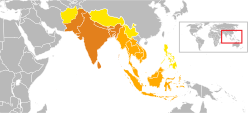Greater India
The term Greater India is most commonly used to encompass the historical and geographic extent of all political entities of the Indian subcontinent and beyond, that had to varying degrees been transformed by the acceptance and induction of cultural and institutional elements of pre-Islamic India. Since around 500 B.C. Asia's expanding land and maritime trade had resulted in prolonged socio-economic and cultural stimulation and diffusion of Hindu and Buddhist beliefs into regional cosmology, in particular in Southeast Asia and Sri Lanka. In Central Asia transmission of ideas were predominantly of religious nature.
By the early centuries of the common era most of the principalities of maritime and continental Southeast Asia had effectively absorbed defining aspects of Hindu culture, religion and administration. The notion of divine god-kingship was introduced by submission to the concept of Harihara, Sanskrit and other Indian epigraphic systems declared official like those of the south Indian Pallava dynasty and Chalukya dynasty. These Indianized Kingdoms, a term coined by George Cœdès were characterized by surprising resilience, political integrity and administrative stability.
To the north Indian religious ideas dissipated into the cosmology of Himalayan peoples, most profoundly in Tibet and Bhutan. Buddhist monasticism extended into Afghanistan, Uzbekistan and other parts of Central Asia and Buddhist texts and ideas successfully reached China and Japan in the east. Unlike Southeast Asia cultural and technological stimulation in East Asia always went in both directions. To the west, Indian culture converges with Greater Persia via the Hindukush and the Pamir Mountains.
...
Wikipedia

